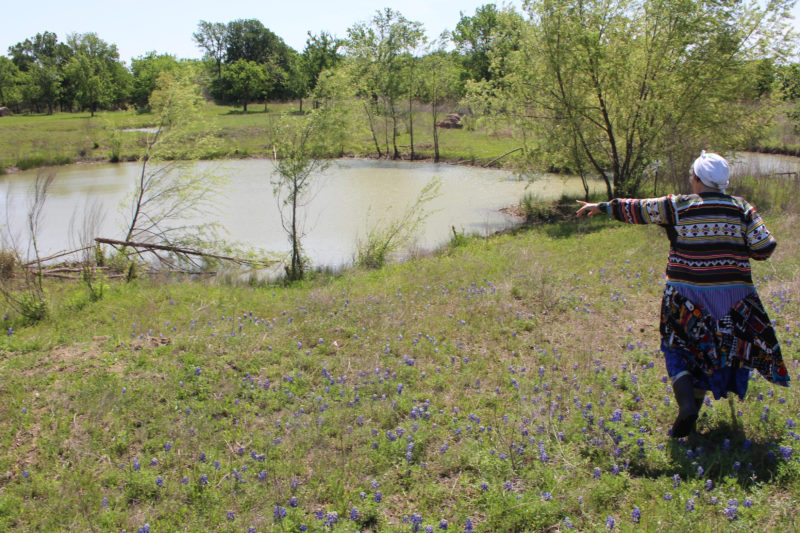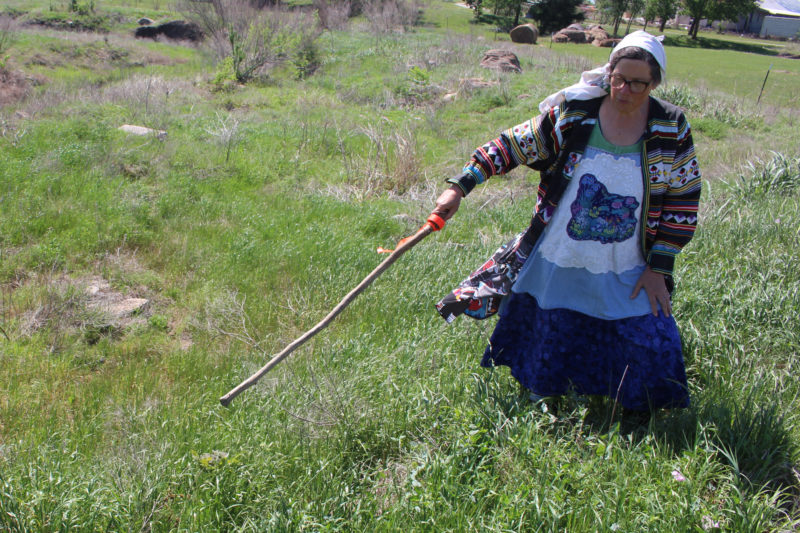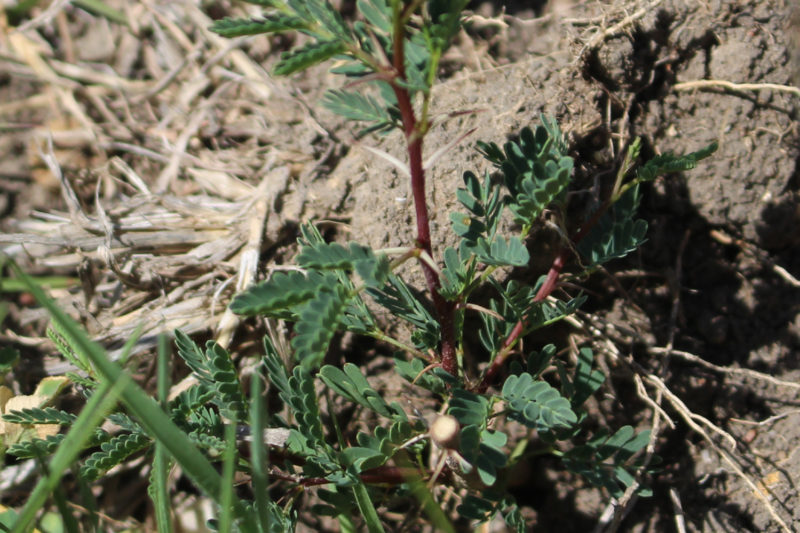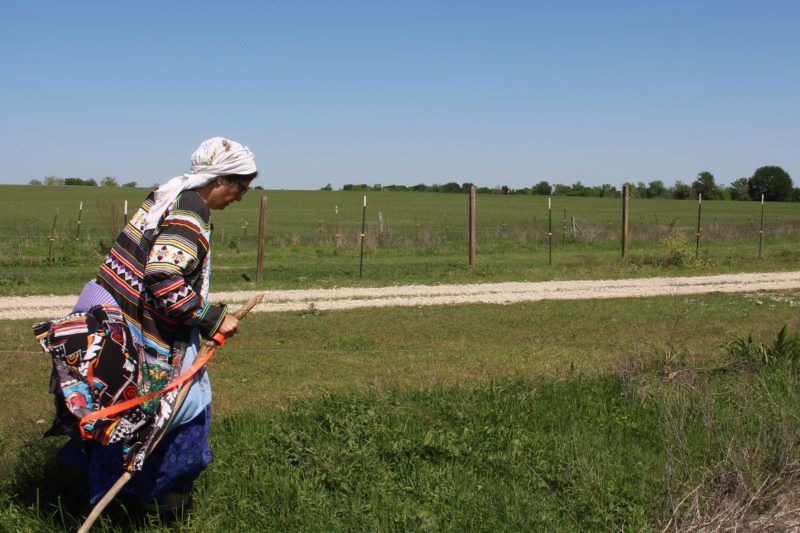TreeFolks’s Carbon Credit Program Taking Root
By Sumaiya Malik
Reporting Texas

Tammy Stutz gives a tour of her property in Elgin, Texas on April 10, 2021. Samuel Bellessa/Reporting Texas
When Tamara Stutz heard about a free tree planting program at her neighbor’s house, she was sold. Coordinators from TreeFolks, an Austin-based non-profit, had reached out to property owners in her neighborhood outside Manor offering to plant trees in an effort to prevent floods.
“This is a 100-year floodplain we are standing on,” Stutz said when Reporting Texas visited in April.
By February 2020, Stutz had more than 1,800 saplings planted on 3⅓ acres of her 30-acre farm. Her part of the bargain: Leave them alone. The trees would fend for themselves. Stutz was so delighted with how the saplings progressed that she asked TreeFolks to come again in 2021.
Stutz gets trees and protection against erosion and everyone benefits from the carbon dioxide-sequestering potential of her saplings. TreeFolks earns carbon credits for planting the trees, which the organization then sells to the City of Austin.
A carbon credit is “a tradable credit granted to a country, company, etc., for reducing emissions of carbon dioxide or other greenhouse gases by one metric ton,” according to the Merrium-Webster dictionary.
TreeFolks earns carbon credits from a third-party certification organization by planting trees. Treefolks then sells the credits. One of its customers is the City of Austin, which spent about $2 million from 2015 to 2020 to offset carbon emissions and repair the urban tree canopy.
Some organizations that emit carbon dioxide are required to buy credits to meet regulatory limits. The City of Austin buys credits in an effort to maintain carbon neutrality and fight climate change. In 2021, TreeFolks for the first time sold carbon credits generated from local reforestation work to a private business, Dwg., an Austin-based urban landscape design company.
The key to the virtuous cycle: An average mature tree absorbs 48 pounds of carbon dioxide per year. In one year, an acre of forest can absorb twice the CO2 produced by the average car’s annual mileage, according to the website 10 Million Trees.
Stutz has owned her property in Manor for about 20 years, and it has a history of flash flooding. The meandering creek that wraps around her farmland, in parts shallow, at others a deep gorge, rose rapidly and submerged the long driveway leading up to the house as well as the lowlands east of the acreage. Before TreeFolks, Stutz would periodically allow a hauling company to dump clean fill and dirt on her property to fill up a ravine. But the storm water would wash it away.
After hearing her neighbor’s story, Stutz, who is 62 and a retired middle school counselor and teacher, went to the TreeFolks website and saw it really wanted to replant floodplains.

Tammy Stutz points out one of the trees planted by TreeFolks on her property in Elgin, Texas on April 10, 2021. Samuel Bellessa/Reporting Texas
In 2020, TreeFolks planted 1,807 saplings on Stutz’s property. Texas-hardy trees included mulberry, live oak, huisache (a type of acacia), wild willows, hackberry, bald cypress, honey locust and pecan. Treefolks planted another 800 in February 2021.
Stutz signed a pledge that she would not remove the saplings for 25 years. Only a quarter of the saplings are expected to survive. Saplings are lost in extreme weather, unexpected flooding and from an attack by land critters.
Andreina Alexatos is director of reforestation at TreeFolks. “We get our saplings from a variety of Texan producers,” Alexatos said. “If a sapling survives year five, its chances of maturity are high.”
TreeFolks was formed in Austin in 1989. It has a current annual revenue of a little less than $1 million and in 2019-2020 engaged over 1,200 volunteers to plant trees in Bastrop, Hays and Travis counties. The non-profit plants thousands of native, drought tolerant and riparian trees in the floodplains of Central Texas as well as in urban East Austin, where the green canopy of the city is lacking.
“We are pioneering this effort in the whole country with private landowners,” Alexatos said.
Once the trees are planted, TreeFolks sends documents and maps of tree locations to City Forest Credits, a Seattle company that has protocols for calculating carbon sequestration. A third party verifies the documents before City Forest issues the credits.
The credits do not all come to TreeFolks in one go. “The first 10% we get within the first year of planting and verified through a third party,” Alexatos said. A lump sum comes in year six and the remainder comes in year 26 when 25 years are over, she said.

A young tree that was planted by TreeFolks grows on Tammy Stutz’s property in Elgin, Texas on April 10, 2021. Stutz hopes the trees planted by TreeFolks will grow up and help control the floodplain on her property for decades to come. Samuel Bellessa/Reporting Texas
Zach Baumer, climate program manager at the city of Austin, oversees its efforts to become carbon neutral. The city buys credits equivalent to 2,000 to 4,000 metric tons of carbon from TreeFolks every year, Baumer said.
“Before this program we would get credits from the open market, but those projects were not in the Austin area,” he said. “We wanted to support credits in the Austin area.”
“Companies that want to offset their carbon emissions will often purchase carbon credits, in order to help build a forest somewhere else in exchange for the carbon that they are producing,” Alexatos said. One carbon credit permits the emission of a mass equal to one metric ton of carbon dioxide.
TreeFolks sells a trademarked version of credits called Carbon+ Credits, which “take into account more ecosystem services than just carbon sequestration. These credits track runoff reduction, air quality improvements, and regional savings in heating and cooling costs,” according to TreeFolk’s website.
TreeFolks charges $30 per metric ton for Carbon+ Credits. The cost is higher than other carbon credits — some sell for as low as for as low as $9 per metric ton. One credit is equal to one metric ton of carbon.
To date TreeFolks have registered 925 credits and sold 221 of them. The City of Austin’s Office of Sustainability will purchase the remaining credits by the end of the year, Alexatos said.
TreeFolks is also working with the city to repair the urban canopy using the Austin Planting Prioritization map. The map shows areas where the city’s tree canopy is deficient. TreeFolks provides saplings that are free to the property owners. The city picks up the cost.
This year the city will spend about $3 million on community forestry projects, said Emily King, urban forester at the city’s Community Tree Preservation Division. Her team is one of many forestry programs the city manages, she said.
At Stutz’s farm, the process potentially sequestered more than 350 metric tons per acre of carbon annually, TreeFolks calculated. She planned to apply for a third round of saplings, she said as she walked toward the creek in her tall rubber boots.
Stutz pointed at the freshly planted saplings with her wooden walking stick. “Hope I am alive long enough to see all those trees,” she said. “That is my dream.”

Tammy Stutz walks along her property in Elgin, Texas on April 10, 2021. Stutz had to fence off the areas TreeFolks planted tree seedlings in order to keep her cows from grazing on them. Samuel Bellessa/Reporting Texas